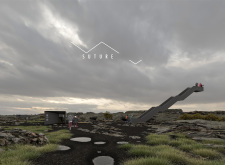5 key facts about this project
The Iceland Cave Tower project is located in a volcanic landscape defined by lava fields and rugged cliffs. This site is not just an aesthetic backdrop; it plays a fundamental role in shaping the overall design. The main goal is to connect visitors with the surrounding nature while providing essential facilities. The design focuses on minimizing impact on the environment, integrating built forms into the natural land to create a cohesive relationship between manmade structures and the landscape.
Site Layout and Visitor Center
The layout features a zigzag path that guides visitors throughout the area, helping them navigate while maintaining a clear sense of direction. The tower and bridge serve as main features, drawing attention and acting as landmarks. The visitor center is conveniently placed near the public cave but remains distant from more private spa areas. This center includes a main space for information and café services, ensuring visitors have access to necessary amenities. Additional facilities like restrooms and storage enhance comfort and convenience.
Specialized Areas
In a more tranquil part of the site, the bath cave and changing facilities are designed to promote a sense of relaxation. This thoughtful placement allows easy access to the Kvennagja Cave spa while providing a peaceful atmosphere. Visitors can move smoothly from the visitor center to the bathing area, with ticket purchases integrated into their journey. This reduces hassle and provides a more enjoyable experience.
Material Choices and Sustainability
Reinforced concrete and steel are the primary materials used, which help ensure the structures are durable and stable. These materials are important given the geological conditions of the area, allowing the buildings to withstand the environmental pressures they may face. Sustainability also influences the design. Geothermal energy is used for heating and lighting, supporting eco-friendly practices. The project captures rainwater and recycles gray water, which contributes to self-sufficiency and shows an understanding of ecological responsibility.
Design Detail
Large glass elements in the visitor center allow for wide views of the surrounding landscape while letting in natural light. This design choice brings the outdoor environment inside, enhancing the visitor experience and creating a stronger connection to the natural world. It serves as a reminder that the location itself is a key part of what makes this site special.





















































